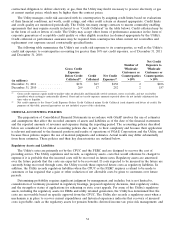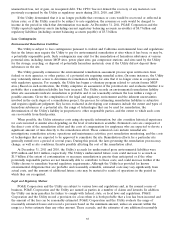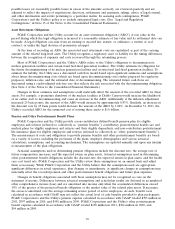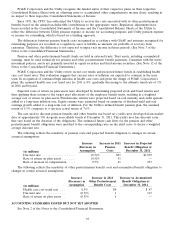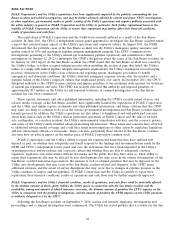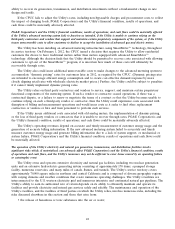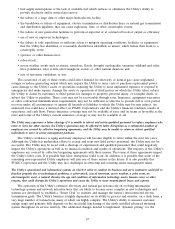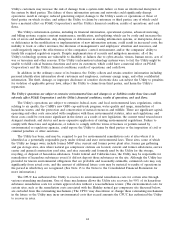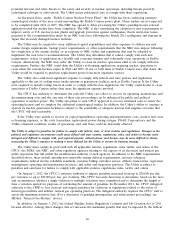PG&E 2011 Annual Report Download - page 46
Download and view the complete annual report
Please find page 46 of the 2011 PG&E annual report below. You can navigate through the pages in the report by either clicking on the pages listed below, or by using the keyword search tool below to find specific information within the annual report.ability to recover its generation, transmission, and distribution investments without a fundamental change in rate
design and tariffs.
If the CPUC fails to adjust the Utility’s rates, including non-bypassable charges and procurement costs, to reflect
the impact of changing loads, PG&E Corporation’s and the Utility’s financial condition, results of operations, and
cash flows could be materially adversely affected.
PG&E Corporation’s and the Utility’s financial conditions, results of operations, and cash flows could be materially affected
if the Utility’s advanced metering system fails to function as intended, if the Utility is unable to continue relying on the
third-party contractors and vendors that support and maintain certain proprietary components of the system, or if the Utility
incurs unrecoverable costs to allow customers to decline to accept the installation of advanced gas and electric meters.
The Utility has been installing an advanced metering infrastructure, using SmartMeter technology, throughout
its service territory. On February 1, 2012, the CPUC issued a decision that requires the Utility to allow residential
customers the choice to have traditional meters rather than meters equipped with advanced SmartMeter
technology. Although the decision finds that the Utility should be permitted to recover costs associated with allowing
customers to opt-out of the SmartMeter program, it is uncertain how much of these costs will ultimately be
recoverable through rates.
The Utility also could incur additional unrecoverable costs to make changes to the advanced metering system to
accommodate ‘‘dynamic pricing’’ rates for customers later in 2012, as required by the CPUC. (Dynamic pricing rates
are intended to encourage efficient energy consumption and to create cost-effective demand response by more
closely aligning retail rates with wholesale electricity market prices.) Further, the Utility could be subject to penalties
if it cannot timely implement dynamic pricing rates.
The Utility relies on third party contractors and vendors to service, support, and maintain certain proprietary
functional components of the metering system. If such a vendor or contractor ceased operations, if there was a
contractual dispute, or a failure to renew or negotiate the terms of a contract so that the Utility becomes unable to
continue relying on such a third-party vendor or contractor, then the Utility could experience costs associated with
disruption of billing and measurement operations and would incur costs as it seeks to find other replacement
contractors or vendors or hire and train personnel to perform such services.
If the Utility incurs additional costs associated with old analog meters, the implementation of dynamic pricing,
or the loss of third-party vendors or contractors that it is unable to recover through rates, PG&E Corporation’s and
the Utility’s financial condition, results of operations, and cash flows could be materially adversely affected.
The Utility’s operating revenues depend on accurate and timely measurement of customer energy usage and the
generation of accurate billing information. If the new advanced metering system failed to accurately and timely
measure customer energy usage and generate billing information due to a lack of system support, or mechanical or
system failure, PG&E Corporation’s and the Utility’s financial condition, results of operations and cash flows could
be materially affected.
The operation of the Utility’s electricity and natural gas generation, transmission, and distribution facilities involve
significant risks which, if materialized, can adversely affect PG&E Corporation’s and the Utility’s financial condition, results
of operations and cash flows, and the Utility’s insurance may not be sufficient to cover losses caused by an operating failure
or catastrophic event.
The Utility owns and operates extensive electricity and natural gas facilities, including two nuclear generation
units and an extensive hydroelectric generating system consisting of approximately 170 dams, a pumped storage
facility, numerous reservoirs, and many miles of canals, flumes, and tunnels. The Utility’s service territory covers
approximately 70,000 square miles in northern and central California and is composed of diverse geographic regions
with varying climates and weather conditions that create numerous operating challenges. The Utility’s facilities are
interconnected to the U.S. western electricity grid and numerous interstate and continental natural gas pipelines. The
Utility’s ability to earn its authorized rate of return depends on its ability to efficiently maintain and operate its
facilities and provide electricity and natural gas services safely and reliably. The maintenance and operation of the
Utility’s facilities, and the facilities of third parties on which the Utility relies, involves numerous risks, including the
risks discussed elsewhere in this section and those that arise from:
• the release of hazardous or toxic substances into the air or water;
42




